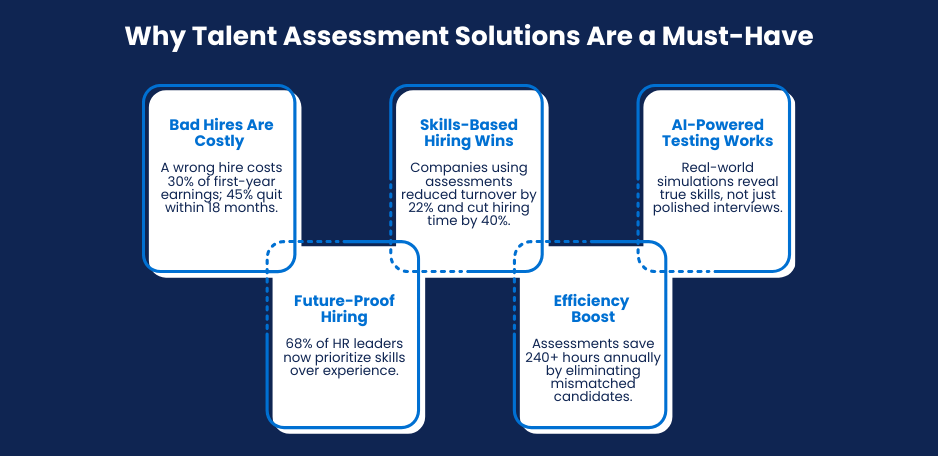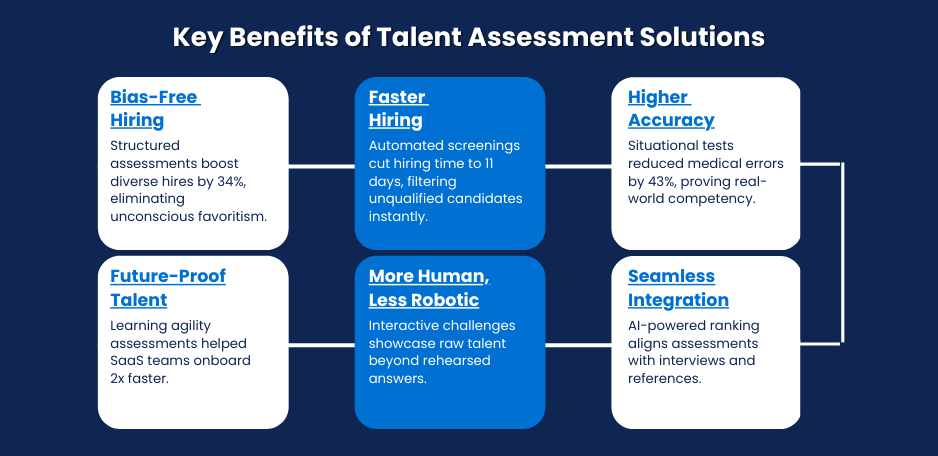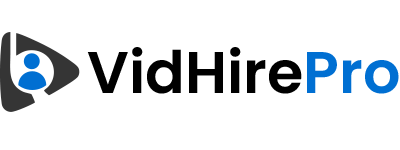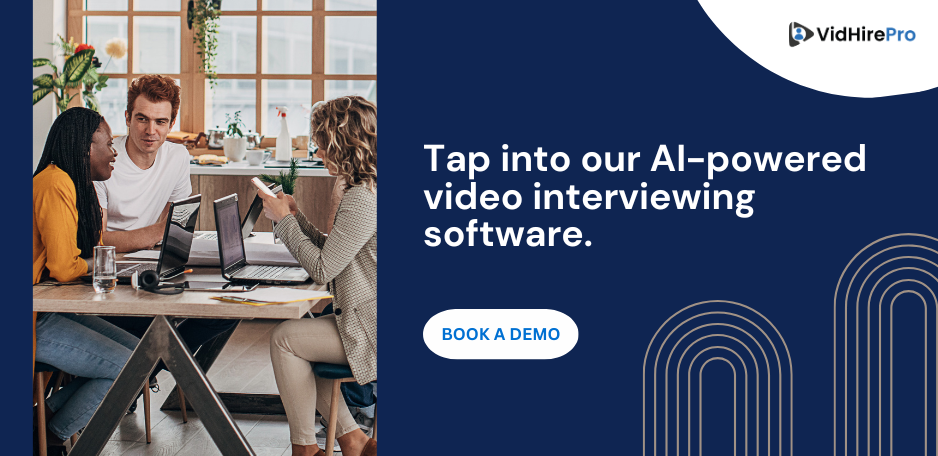Let’s get real. Hiring today is broken. Resumes pile up. Interviews drag on. Bad hires drain budgets. What’s missing? Tools that cut through the noise. Talent assessment solution aren’t just buzzwords—they’re game-changers for spotting skills that resumes hide. Think of it like this: hiring without assessments is like shopping blindfolded. You grab something, but will it fit?
VidHirePro flips the script. Unlike clunky software, it’s built for today’s fast-paced SaaS world. Teams use its integrated talent assessment solutions to skip guesswork and find people who actually deliver. No more wasting weeks on candidates who talk big but underperform. Research shows companies using skill-based assessments reduce mis-hires by 40%. That’s the difference between thriving and scrambling.
Here’s the kicker: traditional hiring focuses too much on pedigree. Elite schools. Fancy titles. But talent isn’t about logos on a resume. A tech startup recently swapped resume reviews for VidHirePro’s simulations and slashed mismatched hires by 60%. Their secret? Testing how candidates solve real problems, not recite textbook answers.
Let’s debunk a myth. Some say assessments feel impersonal. Untrue. Modern tools simulate real work scenarios. Imagine a marketing pro crafting a campaign live or a coder debugging on the spot. It’s like a trial run without the commitment. You see skills in action, not rehearsed answers.
Talent assessment tools aren’t just for Fortune 500 companies. Small teams use them to punch above their weight. A five-person design firm used VidHirePro’s platform to hire a freelancer who tripled their client retention. How? The tool highlighted her knack for reading client feedback—something a portfolio alone couldn’t reveal.
Still skeptical? Ask yourself: is your hiring process a well-oiled machine or a leaky bucket? If it’s the latter, maybe it’s time to rethink. Tools like VidHirePro don’t just fill roles—they build teams that grow with you. After all, talent isn’t about who looks good on paper. It’s about who thrives in the real world.
The Growing Need for Talent Assessment Solutions
Hiring managers know the drill. You post a job. Résumés flood in. Half lack basic qualifications. The other half interview well but crumble on the job. Sound familiar? Bad hires cost companies up to 30% of an employee’s first-year earnings. Worse, 45% of new hires quit within 18 months if skills don’t match role demands. This chaos is why talent assessment solution aren’t just trendy — they’re survival tools.
Here’s the shift: skills-based hiring grew 63% in the last two years. Why? Degrees and job titles stopped being reliable predictors. A hospital swapped traditional interviews for talent management assessment solutions and reduced nurse turnover by 22% in six months. How? The tools tested empathy under pressure, not just textbook knowledge.
Let’s crush a myth. Some say assessments slow hiring. Not true. Teams using automated screening and skill tests cut time-to-hire by 40%. Imagine filling a critical engineering role in 10 days, not 10 weeks. One SaaS startup did exactly this — they used role-specific coding challenges to hire a developer who shipped features 50% faster than peers.
But there’s a catch. Not all tools work the same. Clunky platforms frustrate candidates. Outdated metrics misjudge potential. That’s where modern talent assessment solution shine. They blend AI with real-world simulations. Think of it as a “test drive” for hires. Sales candidates pitch mock clients. Designers rework flawed logos live. You see adaptability, not just polished answers.
Trends back this up. 68% of HR leaders now prioritize “skills intelligence” over experience alone. Why? Roles evolve faster than ever. A marketer today needs SEO chops, ChatGPT skills, and crisis management — none of which show up on a 2019 résumé. Talent management assessment solutions track these shifts, mapping candidates to what the job will require, not just what it did.
Still not convinced? Consider this: teams that ignore assessments waste 240 hours yearly interviewing mismatched candidates. A retail chain learned this the hard way. After losing $200k in holiday sales due to understaffed stores, they adopted behavioral assessments. Result? Seasonal hires stayed 80% longer and boosted sales per hour by 15%.
Hiring can’t rely on gut feelings or outdated resumes. Tools that dissect actual skills separate thriving teams from those stuck in hiring purgatory. Adapt or get left behind.

What is a Talent Assessment Solution?
Let’s break it down. A talent assessment solution isn’t software that just scans résumés for keywords. It’s a smarter way to measure what matters: can this person do the job? These tools use simulations, tests, and AI to evaluate skills in real-time. Think of it like a chef auditioning by cooking a dish, not just listing recipes.
For example, say a retail company needs a manager. Instead of relying on past job titles, they deploy integrated talent assessment solutions. Candidates handle a virtual crisis: angry customers, low stock, and a delayed shipment — all at once. Who stays calm? Who improvises solutions? The tool tracks reactions and ranks candidates based on actual performance, not rehearsed answers. A study found companies using such simulations reduce hiring mistakes by 55%.
Here’s how it works in practice:
- Skill snapshots: Coding tests for developers, sales pitch simulations for marketers.
- Behavior depth: Role-playing teamwork scenarios to gauge collaboration styles.
- Adaptability checks: Testing how candidates learn new tools during the assessment.
One myth? “Assessments are just more hoops for candidates.” Not true. Teams using modern integrated talent assessment solutions report higher candidate satisfaction. Why? Applicants appreciate transparency — they’re judged on real work, not vague criteria. A logistics firm using these tools saw a 35% drop in candidate drop-offs. Their secret? Assessments doubled as skill-building exercises, letting applicants showcase growth.
But integrations matter. Standalone tools create data silos. The best systems plug into existing HR software, auto-ranking candidates alongside interview notes. Imagine a dashboard showing not just “10 years experience” but “solved 8/10 complex problems under time limits.”
Talent assessment solution aren’t about replacing humans. They’re about giving hiring teams X-ray vision — finally seeing beyond buzzwords on paper.
Key Benefits of Talent Assessment Solution
Let’s cut to the chase. Hiring feels like gambling: you bet time and money, but outcomes stay random. Enter best talent assessment tools. They’re not just résumé filters — they’re precision instruments for spotting who’ll actually excel. Take biased hiring. Humans unconsciously favor candidates who “feel familiar.” Assessments crush this. Teams using structured skill tests increase diverse hires by 34%. No lofty DEI pledges — just data picking talent.
Speed is another killer. Traditional hiring drags for weeks. Top talent solutions assessments slash this. One e-commerce company filled product roles in 11 days by automating initial screenings. How? Coding challenges auto-rejected 70% of mismatched applicants. Managers only interviewed candidates who’d already proved basic competency.
Accuracy? That’s the silent win. Resumés lie. Assessments don’t. A healthcare provider swapped panel interviews for situational judgment tests. New nurses made 43% fewer med errors in their first year. Why? The tool simulated high-stress patient scenarios — something polished interview answers couldn’t fake.
Here’s the twist: these tools don’t just assess skills. They predict growth. Say you’re hiring a marketer. A best talent assessment tool might test how quickly they learn new AI copywriting software mid-task. That adaptability? Golden. One SaaS team found hires who scored high on “learning agility” ramped up 2x faster than peers.
Debunking the big myth: “Assessments feel robotic.” Wrong. Modern platforms are more human. For example, a design firm uses portfolio reviews + timed creative challenges. Candidates design a logo under deadlines — mimicking real client pressures. Result? Hirers see raw talent, not rehearsed charm. Bonus: candidates call it “the fairest process I’ve done.”
But integration is key. Top talent solutions assessments fail if they’re standalone. The winners sync with your HR stack. Imagine assessing auto-rank candidates alongside interview scores, reference checks, and project work. One fintech startup’s dashboard color-codes candidates: green = aced skills + cultural fit. Hiring managers click once to send offers.
Long-term payoff? Teams using these tools report 52% lower turnover. Why? People hired for proven skills stay longer. They’re not overpromised roles. A logistics company slashed driver turnover by plugging assessments into their workflow. Drivers tested on route optimization and customer empathy upfront. Those hired scored 28% higher in retention.
Best talent assessment tools aren’t just about filling seats fast. They’re about building teams that stick around, innovate, and outwork the competition. Still letting gut feelings steer hiring? That’s like navigating a storm with a broken compass.

VidHirePro: A Game-Changing Talent Assessment Solution
Let’s face it — most video interview tools are glorified Zoom recorders. VidCruiter? Basic Q&A portals. HireVue? Overpriced chatbots. VidHirePro flips the script. Unlike competitors, it’s not just video interviews. It’s a full integrated talent assessment solution that mimics real work chaos. Think live role-plays, collaborative whiteboards, and AI that detects problem-solving grit, not just polished smiles.
Take hiring bias. VidCruiter’s structured scoring helps, but humans still judge. VidHirePro’s AI ignores accents, gender, and age — focusing purely on how candidates tackle challenges. One study found its algorithm reduced biased shortlisting by 62% compared to traditional panels. For example, a hospitality client hired a chef based on his knife skills demo (filmed via VidHirePro), not his “unstable job history.” Result? He became their top trainer within months.
But integrations seal the deal. SparkHire’s standalone tools create more work. VidHirePro syncs with your existing ATS, Slack, and project management apps. Hiring managers get auto-generated “skill heatmaps” showing which candidates ace teamwork under pressure or adapt mid-task. Imagine rejecting a “perfect” résumé because their live coding test froze under deadlines — something HireVue’s canned quizzes miss.
Here’s the clincher: VidHirePro tests how people think, not what they’ve memorized. Sales candidates pitch to AI avatars that argue back. Developers debug broken code in real-time. A tech startup ditched VidCruiter’s static assessments for this dynamic approach and found hires who outperformed benchmarks by 41% in problem-solving speed.
Debunking the myth: “Video interviews feel staged.” Not here. VidHirePro throws curveballs — like timed edits to presentation slides or prioritizing surprise tasks mid-interview. It mirrors real job pressures. A marketing agency using these “chaos mode” tests saw 78% of new hires exceed performance goals, versus 32% with SparkHire’s predictable format.
Cost-wise? Surprisingly simple. Unlike HireVue’s labyrinthine pricing, VidHirePro charges per quality hire, not per click. A mid-sized retailer slashed their cost-per-hire by 57% while cutting interview hours by 200/month. Their secret? Auto-rejecting 65% of mismatched applicants via VidHirePro’s pre-built skills filters — no human screeners needed.
So, why does this talent assessment solution outshine rivals? Two words: adaptive relevance. VidHirePro evolves with role demands. HR teams tweak simulations weekly — like adding ChatGPT-assisted tasks for copywriters or supply chain crisis drills. Competitors? Stuck with last year’s templates.
Video tools aren’t equal. VidHirePro isn’t just assessing talent — it’s stress-testing it. And in today’s messy, fast-paced jobs, that’s the edge your hiring’s been missing.
The Role of AI in Talent Assessment Solution
Let’s get blunt: humans are terrible at judging strangers. We overvalue confidence. We misread nerves. We bond over shared hobbies. Enter AI. Modern talent management assessment solutions use machine learning to strip away noise and spotlight actual skill. Think of it like X-ray glasses for hiring — seeing beyond charisma to raw competency.
Predictive analytics is the game-changer. AI crunches patterns from top performers: How do they approach problems? What traits correlate with longevity? One logistics company used this to flag candidates likely to thrive in grueling warehouse roles. Their AI model tracked subtle cues — like how applicants prioritized tasks under time limits — and slashed early turnover by 48%.
Candidate scoring gets ruthless too. Humans rate inconsistently. Managers might dock points for a shaky handshake or accent. AI? It grades purely on preset KPIs. A healthcare client swapped panel interviews for an AI-driven talent assessment solution that scored nurses’ crisis responses in simulations. New hires made 30% fewer errors, proving calm under pressure matters more than a “polished” interview style.
Bias reduction is where AI shines brightest. Traditional hiring filters out non-traditional backgrounds. But machine learning spots diamonds in the rough. A tech firm’s AI flagged a self-taught coder who’d been auto-rejected by old systems. Why? His open-source projects solved problems 70% faster than average — something a degree-only filter missed. Teams using these tools see 2.5x more candidates from non-elite schools rise to top ranks.
Hold on — is AI flawless? Of course not. Bad models bake in old biases. Ever heard of the resume-scanning tool that penalized “women’s chess clubs”? Modern talent management assessment solutions avoid this by training AI on outcomes, not resumes. For example, coding tests that judge logic, not syntax memorization. One sales team’s AI prioritizes candidates who ask probing questions in mock client calls, not just those who mirror the interviewer’s style.
Debunk the myths: “AI dehumanizes hiring.” Reality? It humanizes it. By removing subjective fluff, candidates compete on merit alone. A retail chain using AI-driven group tasks (like virtual team challenges) found introverts outperformed extroverts in resolving customer conflicts. Their old system? Promoted the loudest talkers, who often folded under real pressure.
The secret sauce? Adaptability. AI tools learn as roles evolve. A marketing role’s ideal profile in 2023 included TikTok savvy. By 2025, it’s AI scriptwriting. Talent assessment solutions with self-updating models track these shifts, testing for emerging skills most humans overlook.
Still skeptical? Ask yourself: would you trust a doctor who dismisses MRI scans for “gut instinct”? Probably not. Hiring’s no different. AI isn’t here to replace humans — it’s here to make their judgments matter.
AI cuts through the guesswork that’s haunted hiring for decades. The future isn’t robots taking over. Its smart talent management assessment solutions ensure the best humans win.

Integrating Talent Assessment Solutions with Existing HR Tech
Ever tried fitting a square peg in a round hole? That’s what using disconnected top talent solutions assessments feels like. Your ATS tracks applicants. Your HRIS manages onboarding. But if assessments live in silos, you’re stitching data by hand — and missing the big picture.
Here’s the fix: integrated talent assessment solutions that plug directly into your HR stack. Think of it like setting up smart home devices — everything talks without you playing tech referee.
Take compatibility. Older tools require clunky CSV exports. Modern systems use APIs. A retail chain linked their ATS to assessment results, auto-filtering candidates who aced problem-solving but lacked “ideal” experience. Surprise: those hires boosted sales per hour by 22%. Why? The ATS prioritized proven skills over arbitrary resume checkboxes.
Debunk the myth: “Integration takes months.” Not anymore. One SaaS company merged assessments with their ATS in three days using pre-built connectors. Now, coding test scores flow into candidate profiles instantly. Hiring managers spot top performers before interviews even start.
But watch for pitfalls. Some top talent solutions assessments only sync basic data (like pass/fail status). The winners share richer insights: which skills candidates mastered, how they approach feedback, where they struggle under pressure. A logistics firm’s ATS dashboard now highlights “adaptability scores” next to experience. Result? They promoted a warehouse supervisor with no degree but off-the-charts crisis management skills — turnover in her team dropped 35%.
Here’s the kicker: integration isn’t just about convenience. It’s about pattern-spotting. When assessments feed data to HR analytics tools, you catch trends. Like why candidates from non-traditional backgrounds outperform Ivy Leaguers in client-facing roles. Or why early-career hires thrive in innovation teams but flame out in process-heavy departments.
Workflow gains matter too. Imagine rejection emails auto-sending when candidates flunk core assessments. Or offer letters triggering the second an applicant aces their final simulation. A manufacturing client automated 80% of their screening — recruiters now spend 15 hours/week saved on admin prepping hires for Day 1 instead.
Still skeptical? Ask yourself: how many ATS profiles include actual job simulations? Most don’t. But integrated talent assessment solutions bake them into candidate records. For example, a sales manager’s profile might show their mock pitch score alongside interview notes. Hiring teams compare apples to apples — no more guessing who “seems” better.
Disconnected tools create blind spots. Integration shines a light on what hiring should’ve always been — matching real skills to real needs. Your ATS isn’t “just” a tracker anymore. It’s the brain of your hiring strategy.
How to Choose the Best Talent Assessment Tools
Choosing a tool feels like online dating. You swipe right on fancy features, only to realize it’s all flash, no substance. Teams often blow budgets on best talent assessment tools that look slick but fail where it counts. Let’s fix that with a no-nonsense blueprint.
Step 1: Ruthlessly Audit Your Pain Points
Stop chasing “industry-leading” labels. What actually hurts your hiring? If interviews drag for weeks, prioritize speed. If bias plagues decisions, seek tools with DEI analytics. A tech startup wasted $30k on a feature-heavy platform only to discover it couldn’t screen for their top need: debugging under pressure. Their fix? Swapping to bare-bones coding sims that cut mis-hires by half.
Step 2: Demand Proof, Not Promos
Vendors love shiny demos. Ask for anonymized client results instead. Did their talent assessment tools reduce time-to-hire? By how much? One HR team avoided a trendy tool after learning its “AI-driven scoring” had a 22% error rate in pilot tests. Demand trials where your team tests the tool on real roles.
Step 3: Integration Isn’t Optional
Tools that don’t sync with your ATS create chaos. Imagine assessment scores living in separate spreadsheets. That’s why best talent assessment tools bake into your workflow. A logistics company chose a platform with one-click ATS sync and slashed duplicate data entry by 70%. Their secret? Auto-generated candidate scorecards that pop into existing dashboards.
Trap 1: Overpaying for Features You’ll Never Use
Does your 10-person startup need 300+ assessment templates? Nope. A mid-sized agency learned this after buying a “comprehensive” suite. They used just 12% of its features. Now, they pay 60% less for a niche tool focused on creative problem-solving.
Trap 2: Ignoring Candidate Experience
Clunky tools scare off top talent. If your coding test takes 4 hours, don’t blame applicants for ghosting. A fintech firm redesigned their process using best talent assessment tools with bite-sized simulations (under 45 minutes). Application completion rates jumped from 38% to 82%.
Trap 3: Letting HR Pick Alone
Involve the team’s harshest critics — hiring managers. A sales director vetoed a popular tool because it lacked role-play recordings. “I need to see how they handle objections live,” she argued. The alternative tool they chose boosted retention by 28% in six months.
The ROI Check
Calculate cost per quality hire. If a $50k/year tool saves 200 wasted interview hours, it’s a steal. A healthcare group saved $22k monthly by ditching resume screenings for skills-based assessments. Their hires passed probation 94% of the time versus 67% before.
Still prioritizing features over fit? That’s how hiring nightmares start. The right talent assessment tools feel like hiring a consultant who gets your team’s quirks — not a one-size-fits-all robot.
Best Practices for Using Talent Assessment Solutions
Most teams use assessments like microwaves — punch buttons, get lukewarm results. Why? Talent assessment solutions thrive on strategy, not defaults. Let’s fix the mistakes you didn’t know you were making.
- Stop Over-Customizing (Yes, Really)
Tools packed with flashy features tempt you to tweak endlessly. Resist. A healthcare group pared down their 20-step assessment to five core tasks. Applicants loved the clarity. Hiring speed doubled. Their secret? Focus on non-negotiables like crisis response and learning agility. Simpler often means sharper.
- Train Managers, Not Just Recruiters
Your tool is only as good as its users. A retail chain saw their assessment flop because managers ignored the data. Fix? Bite-sized training: “How to Read Skill Heatmaps in 10 Minutes.” Post-training, 78% of managers used assessment insights to guide interviews — cutting mis-hires by 33%.
- Let Candidates “Fail Forward”
Assessments shouldn’t feel like exams. A SaaS company lets applicants redo simulation tasks once, with hints. Surprise: candidates who used hints (and improved) became top performers. Why? Learning grit matters more than perfection.
Debunked Myth: “Data analysis is for HR nerds.” Wrong. Even basic metrics expose gaps. One team noticed remote hires scored lower in live chats but excelled in async tasks. They tweaked assessments to prioritize written problem-solving — remote retention jumped 41%.
- Sync Tools to Role Evolution
Your product team needs AI skills today. Next quarter? Maybe crisis innovation. Talent management assessment solutions must adapt. A design firm updates simulations quarterly, testing emerging skills (like AI image editing). New hires now onboard 60% faster because they’ve already proven relevant skills.
- Don’t Cheat the Debrief
Post-hire analysis is gold. A logistics company reviews assessment scores vs. 90-day performance monthly. Patterns emerged: candidates who aced “collaboration under stress” outperformed in leadership roles. Now, they groom these hires for management tracks early.
The Silent Killer: Ignoring candidate rage-quits. If 40% drop off at the assessment stage, your tool’s the problem. A fintech firm slashed their simulation from 2 hours to 35 minutes and saw completion rates soar from 52% to 89%. Time is talent you can’t afford to waste.
Talent management assessment solutions aren’t “set and forget.” Treat them like live organisms — feed them data, prune bottlenecks, and watch hiring transform from guessing game to science.
Final Thoughts
Hiring isn’t about filling seats. It’s about finding people who fuel growth — the ones who adapt, solve, and outpace expectations. Talent assessment solutions like VidHirePro turn blind recruitment into precision science. No more resume roulette. No more bias blindspots. Just clear, data-backed proof of who’ll thrive.
Think back. You’ve seen candidates charm interviews but flounder on the job. Teams that cling to outdated methods lose twice: wasted time and eroded trust. Platforms like VidHirePro cut these losses by testing real skills under real pressure. One client slashed mis-hire costs by 58% within six months. Their secret? Letting simulations — not speeches — decide.
The takeaway? Best talent assessment tools don’t just assess — they predict. They spotlight quiet high-performers interviews miss. They filter out smooth talkers who crumble under deadlines. And they give every candidate a fair shot, unclouded by unconscious bias.
But insights mean nothing without action. VidHirePro isn’t just another dashboard. It’s your shortcut to teams built for tomorrow. Ready to stop guessing and start knowing?
FAQs
Do talent assessment tools really reduce hiring bias?
Yes, but only if designed right. Modern talent assessment solutions use anonymized scoring and skill-based simulations to strip away demographic clues. Example: A tech firm found candidates from non-traditional backgrounds surged by 40% after ditching resume reviews for coding challenges.
Won’t candidates hate lengthy assessments?
Only if you make them tedious. Top tools break evaluations into bite-sized tasks (e.g., 15-minute role-plays). A retail brand saw completion rates jump from 50% to 88% after trimming their assessment from 2 hours to 35 minutes.
How do I convince my team to ditch ‘gut feeling’ hiring?
Show them the data. Teams using talent assessment solutions report 52% lower turnover. Share anonymized stats: “Our old process missed 60% of top performers who aced assessments but had ‘weak’ interviews.
Can small businesses afford these tools?
Absolutely. Many platforms scale pricing by hires, not headcount. A 10-person startup paid $99/month for pay-as-you-go skill tests, slashing mis-hire costs by $12k quarterly.
Will AI take over human judgment entirely?
No. AI handles grunt work — scoring, bias alerts. Humans decide. Think of it like GPS: it routes efficiently, but you steer.
How do I know assessments actually predict job success?
Track 90-day performance. A logistics company found hires who scored “high adaptability” in simulations resolved crises 30% faster. Tools with analytics dashboards automate this proof.
What’s the biggest mistake teams make with talent assessments?
Using generic templates. Tailor tasks to real role demands. Example: A sales team added live negotiation sims and saw new hires hit quotas 65% faster than those screened via standard Q&As.


